Laboratory Evaluation of the Properties of Asphalt Mixture with Wood Ash Filler
Abstract
:1. Introduction
2. State of the Art
3. Objective of This Study
4. Materials
4.1. Aggregates
4.2. Filler
4.3. Asphalt Binder
4.4. Composition of the Asphalt Mixtures
- A mixture with 100% of the mineral filler (control mixture)
- B mixture with 25% WA, 75% mineral filler
- C mixture with 50% WA, 50% mineral filler
- D mixture with 75% WA, 25% mineral filler
5. Test Methods
5.1. Methods for Testing the Release of Hazardous Substances from WA
5.2. Methods for Testing WA as a Filler
- difference of softening points ΔR&B according to HRN EN 13179-1;
- sensitivity of the filler to water according to HRN EN 1744-4; and
- bitumen number according to HRN EN 13179-2.
5.3. Testing the Physical and Mechanical Properties of Asphalt Mixtures
5.4. Testing the Sensitivity of Asphalt Samples to Water
6. Results and Discussion
6.1. The Results of Hazardous Substance Release from WA
6.2. The Results of Testing WA as an Added Filler
6.3. The Impact of WA on the Volumetric Properties of the Asphalt Mixture
6.4. The Impact of WA on the Results of the Stability and Stiffness According to Marshall
6.5. The Impact of WA on the Results of Indirect Tensile Strength—ITS
7. Conclusions
- The results of the tested properties of WA as an added filler in asphalt mixtures confirm that there are no major deviations from the values for the mineral stone fillers prescribed by the standard. Due to the observed hazardous substances (Table 3), WA cannot be deposited at landfills as its own internal waste on its own or in a mixture with other internal waste materials with similar properties. However, bound with bitumen and built in an asphalt layer in a pavement structure, it is a part of the structure and should not be harmful to the environment.
- The results of Marshall stability (MS) and Marshall quotient (MQ) showed that with increased content of WA in the filler up to 50%, the MS and MQ values also increase. Marshall stability (MS) increased by 4.5% (from 11.1 kN to 11.6 kN). The greater stability value divided by deformation indicates a mixture with greater stiffness and an Marshall quotient (MQ) increase by 15.0% (from 5.3 kN/mm to 6.1 kN/mm). The obtained results of MS and MQ had a direct effect on the greater resistance of asphalt to rutting under traffic load. For mixture D, with 75% WA, the MS (10.9 kN) and MQ (5.2 kN/mm) values were lower than the values of the other asphalt mixtures, but even with this reduced stability and stiffness, mixture D met the required Croatian technical criteria for application in the asphalt layer.
- The tensile strength results of dry samples (ITSd) showed that with an increased content of WA in the filler up to 50%, ITSd results increased by 10.7% (from 2.250 kPa to 2.490 kPa). This result confirms a lower risk of cracks and a longer period of asphalt durability in exploitative conditions, respectively, better resistance to the degree of material fatigue. The samples of mixture D with a 75% WA content had a lower tensile strength than the other asphalt mixtures with WA (ITSd =2.260 kPa) but still were better than control mixture without WA (ITSd =2.250 kPa).
- The indirect tensile strengths ratio results (ITSR = ITSw/ITSd) confirmed good resistance of the asphalt samples to the effect of water. The values ranged from 81% to 98% in all of the tested samples. All three of the mixtures with WA had a lower ITSR value than the control mixture without WA, which indicates that the increase of WA content in the filler resulted in a reduction of ITSR (93%, 89%, 81%). Since mixtures with a higher content of WA are less resistant to water, the optimum content of WA in the filler needs to be limited to 50%.
- Although an increase in the content of voids in the mixtures (3.9%, 4.0%, 4.3%, 4.6%) was noticed with the increase of the content of WA (0%, 25%, 50%, 75%), the three mixtures with WA meet the criteria prescribed by Croatian technical criteria and, according to their physical and mechanical properties, they could be used in construction of asphalt pavements. However, according the ITRS results, the optimum content of WA in the filler needs to be limited to 50%.
- This research confirmed the possibility of using cyclonic wood ash as a resource in the form of a constituent material of asphalt mixtures. Usage of wood ash can give economic and ecological benefits, in full accordance with the guidelines of sustainable development:
- (a)
- Usage of WA reduces the number of landfills and quantity of waste in landfills. About 110 t of wood biomass are combusted daily, which represents an annual consumption of about 40,000 tons of wood biomass. Wood ash is also produced during combustion, in an amount of approximately 4% of the combusted biomass, or about 3–4 tons per day. The daily quantities of produced ash are significant. Currently, there is no systematic method for recovering the ash; it is mostly deposited in landfills. Depositing in landfills is demanding and expensive and takes up valuable space. Given that the WA is characterized as non-hazardous waste and that large amounts of WA are expected in landfills, its reuse/recycling is strongly encouraged.
- (b)
- Usage of WA reduces the construction costs of pavement structures. The cost of asphalt mixture with up to 50% wood ash in a filler is 2–4% less than the cost of asphalt mixtures with a mineral filler (industrial). Given that asphalt mixtures are mixtures whose price significantly increases each project’s cost, even the smallest cost savings is desirable and welcomed.
- (c)
- Usage of WA reduces the need for natural aggregates and protects the environment. Savings in the cost of industrial filler production and protection of limited quantities of natural limestone and dolomite resources are achieved.
Author Contributions
Funding
Data Availability Statement
Acknowledgments
Conflicts of Interest
Abbreviations
References
- Zagvozda, M.; Dimter, S.; Rukavina, T. The potential of bioash for utilization in road construction in eastern Croatia. Sel. Sci. Pap. J. Civ. Eng. 2017, 12, 121–127. [Google Scholar] [CrossRef] [Green Version]
- European Union. Directive 2009/28/EC of the European Parliament and of the Council of 23 April on the promotion of the use of energy from renewable sources. Off. J. Eur. Union 2009, 140, 16–62. [Google Scholar]
- HROTE. Data from the System of Incentives Measures for Renewable Energy Sources. Available online: https://files.hrote.hr/files/PDF/Sklopljeni%20ugovori/PP_HR_04_05_2020.pdf (accessed on 19 May 2020). (In Croatian).
- Demirbas, A. Potential applications of renewable energy sources, biomass combustion problems in boiler power systems and combustion related environmental issues. Prog. Energy Combust. Sci. 2005, 31, 171–192. [Google Scholar] [CrossRef]
- Zagvozda, M.; Dimter, S.; Rukavina, T.; Grubeša, I.N. Possibilities for using bioash in road construction. Građevinar 2018, 70, 393–402. Available online: https://scholar.google.com/scholar?cluster=16027470536799857565&hl=en&as_sdt=2005&sciodt=0,5 (accessed on 10 July 2020).
- Lanzerstorfer, C. Chemical composition and physical properties of filter fly ashes from eight grate-fired biomass combustion plants. J. Environ. Sci. 2015, 30, 191–197. [Google Scholar] [CrossRef]
- Vanhanen, H.; Dahl, O.; Joensuu, S. Utilization of wood ash as a road construction material—Sustainable use of wood ashes. In Proceedings of the 2nd International Conference on Final Sinks, Espoo, Finland, 16–18 May 2013. [Google Scholar]
- James, A.K.; Thring, R.W.; Helle, S.; Ghuman, H.S. Ash Management Review—Applications of Biomass Bottom Ash. Energies 2012, 5, 3856–3873. [Google Scholar] [CrossRef]
- Dimter, S.; Rukavina, T.; Barišić, I. Alternative, environmentally acceptable materials in road construction. In Handbook of Research on Advancements in Environmental Engineering; Gaurina-Međimurec, N., Ed.; IGI Global: Hershey, PA, USA, 2014; pp. 557–583. [Google Scholar]
- Supancic, K.; Obernberger, I. Wood ash utilization as a stabilizer in road construction—First results of large-scale tests. In Proceedings of the 19th European Biomass Conference and Exhibition, Berlin, Germany, 6–10 June 2011; pp. 859–870. [Google Scholar]
- Sarkkinen, M.; Kujala, K.; Kemppainen, K.; Gehör, S. Effect of biomass fly ashes as road stabilisation binder. Road Mater. Pavement Des. 2018, 19, 239–251. [Google Scholar] [CrossRef]
- Bohrn, G.; Stampfer, K. Untreated Wood Ash as a Structural Stabilizing Material in Forest Roads. Croat. J. For. Eng. 2014, 35, 81–90. [Google Scholar]
- Ureña, C.; Azañón, J.M.; Caro, J.M.; Irigaray, C.; Corpas, F.; Ramírez, A.; Rivas, F.; Salazar, L.M.; Mochón, I. Use of the biomass Ash as a stabilization agent for expansive marly soils (SE Spain). In Proceedings of the EGU General Assembly, Vienna, Austria, 22–27 April 2012. [Google Scholar]
- Emeh, C.; Igwe, O. The combined effect of wood ash and lime on the engineering properties of expansive soils. Int. J. Geotech. Eng. 2016, 10, 246–256. [Google Scholar] [CrossRef]
- Okagbue, C.O. Stabilization of Clay Using Woodash. J. Mater. Civ. Eng. 2007, 19, 14–18. [Google Scholar] [CrossRef]
- Šķēls, P.; Bondars, K.; Plonis, R.; Haritonovs, V.; Paeglītis, A. Usage of Wood Fly Ash in Stabilization of Unbound Pavement Layers and Soils. In Proceedings of the 13th Baltic Sea Geotechnical Conference, Vilnius, Lithuania, 22–24 September 2016; pp. 122–125. [Google Scholar]
- Sarkkinen, M.; Luukkonen, T.; Kemppainen, K. A wasterock and bio ash mixture as a road stabilization product. In Proceedings of the 3rd Edition of the International Conference on Wastes: Solution, Treatments and Opportunities, Viana do Castelo, Portugal, 14–16 September 2015; pp. 283–288. [Google Scholar]
- Vestin, J.; Arm, M.; Nordmark, D.; Lagerkvist, A.; Hallgren, P.; Lind, B. Fly ash as a road construction material. In Proceedings of the WASCON 2012 Conference, Gothenburg, Sweden, 30 May–1 June 2012; pp. 1–8. [Google Scholar]
- Kaakkurivaara, T.; Kolisoja, P.; Uusitalo, J.; Vuorimies, N. Fly Ash in Forest Road Rehabilitation. Croat. J. For. Eng. 2009, 37, 119–130. [Google Scholar]
- Šķēls, P.; Bondars, K.; Haritonovs, V. Wood fly ash stabilization of unbound pavement layers. In Proceedings of the 19th International Conference on Soil Mechanics and Geotechnical Engineering (ICSMGE 2017), Coex Convention Center, Seoul, Korea, 17–21 September 2017. [Google Scholar]
- Berra, M.; Mangialardi, T.; Paolini, A.E. Reuse of woody biomass fly ash in cement-based materials. Constr. Build. Mater. 2015, 76, 286–296. [Google Scholar] [CrossRef]
- Beltrán, M.G.; Agrela, F.; Barbudo, A.; Ayuso, J.; Ramírez, A. Mechanical and durability properties of concretes manufactured with biomass bottom ash and recycled coarse aggregates. Constr. Build. Mater. 2014, 72, 231–238. [Google Scholar] [CrossRef]
- Mirković, K.; Tošić, N.; Mladenović, G. Effect of Different Types of Fly Ash on Properties of Asphalt Mixtures. Adv. Civ. Eng. 2019, 2019, 1–11. [Google Scholar] [CrossRef]
- Androjić, I.; Kaluđer, G. Influence of recycled filler on asphalt mix properties. Građevinar 2017, 69, 207–214. [Google Scholar] [CrossRef] [Green Version]
- Tapkın, S. Mechanical evaluation of asphalt–aggregate mixtures prepared with fly ash as a filler replacement. Can. J. Civ. Eng. 2008, 35, 27–40. [Google Scholar] [CrossRef]
- Ramme, B.W.; Covi, A.; Faheem, A.; Sobolev, K. Fly Ash—An Important Ingredient for use in Hot-Mix Asphalt Concrete. In Proceedings of the Fourth International Conference on Sustainable Construction Materials and Technologies, Las Vegas, NV, USA, 7–11 August 2016; pp. 1–9. [Google Scholar]
- Hassan, M.M.; Al-Khalid, H. Mechanical and environmental characteristics of bituminous mixtures with incinerator bottom ash aggregates. Int. J. Pavement Eng. 2010, 11, 83–94. [Google Scholar] [CrossRef]
- Topini, D.; Toraldo, E.; Andena, L.; Mariani, E. Use of recycled fillers in bituminous mixtures for road pavements. Constr. Build. Mater. 2018, 159, 189–197. [Google Scholar] [CrossRef]
- Pasandín, A.R.; Pérez, I.; Ramírez, A.; Cano, M.M. Moisture damage resistance of hot-mix asphalt made with paper industry wastes as filler. J. Clean. Prod. 2016, 112, 853–862. [Google Scholar] [CrossRef] [Green Version]
- Melotti, R.; Santagata, E.; Bassani, M.; Salvo, M.; Rizzo, S. A preliminary investigation into the physical and chemical properties of biomass ashes used as aggregate fillers for bituminous mixtures. Waste Manag. 2013, 33, 1906–1917. [Google Scholar] [CrossRef]
- Karahancer, S.; Saltan, M.; Morova, N.; Serin, S.; Terzi, S. Evaluation of rice husk ash as filler in hot mix asphalt concrete. Constr. Build. Mater. 2013, 48, 390–397. [Google Scholar] [CrossRef]
- Al-Hdabi, A. Laboratory investigation on the properties of asphalt concrete mixture with Rice Husk Ash as filler. Constr. Build. Mater. 2016, 126, 544–551. [Google Scholar] [CrossRef]
- Tahami, S.A.; Arabani, M.; Mirhosseini, A.F. Usage of two biomass ashes as filler in hot mix asphalt. Constr. Build. Mater. 2018, 170, 547–556. [Google Scholar] [CrossRef]
- Bi, Y.; Jakarni, F. Evaluating properties of wood ash modified asphalt mixtures. IOP Conf. Ser. Mater. Sci. Eng. 2019, 512, 012004. [Google Scholar] [CrossRef]
- Boura, S.A.; Hesami, S. Laboratory evaluation of the performance of asphalt mixtures containing biomass fillers. Road Mater. Pavement Des. 2019, 21, 2040–2053. [Google Scholar] [CrossRef]
- Xue, Y.; Wu, S.; Cai, J.; Zhou, M.; Zha, J. Effects of two biomass ashes on asphalt binder: Dynamic shear rheological characteristic analysis. Constr. Build. Mater. 2014, 56, 7–15. [Google Scholar] [CrossRef]
- Arabani, M.; Esmaaeli, N. Laboratory evaluation on effect of groundnut shell ash on performance parameters of asphalt binder and mixes. Road Mater. Pavement Des. 2018, 21, 1565–1587. [Google Scholar] [CrossRef]
- Zagvozda, M. Low Volume Roads Pavement Structure Base Layer with Bio Ash as Binder. Ph.D. Thesis, University of Zagreb, Faculty of Civil Engineering, Zagreb, Croatia, 2018. (In Croatian). [Google Scholar]
- Fistric, M.; Grubjesic, G.; Krnic, L.; Lackovic, V.; Medved, M.; Modric, D.; Palkovic, B.; Radivoj, T.; Rukavina, T.; Skender, R.; et al. Technical Requirements for Asphalt Pavements, Croatian Roads. Zagreb, Croatia. 2015. Available online: https://hrvatske-ceste.hr/uploads/documents/attachment_file/file/260/Tehni%C4%8Dki_uvjeti_za_asfaltne_kolnike.pdf (accessed on 12 December 2020). (In Croatian).
- HRN EN13108-1:2016. Bituminous Mixtures—Material Specifications—Part 1: Asphalt Concrete; CEN: Brussels, Belgium, 2016. [Google Scholar]
- HRN EN12591:2009. Bitumen and Bituminous Binders—Specifications for Paving Grade Bitumens; CEN: Brussels, Belgium, 2009. [Google Scholar]
- HRN EN 13043:2003. Aggregates for Bituminous Mixtures and Surface Treatments for Roads, Airfields and Other Trafficked Areas; CEN: Brussels, Belgium, 2003. [Google Scholar]
- Croatian Geological Survey. Testing Report on the Mineral Composition of Ash Samples by X-Ray Diffraction Method (XRD) No. 65/19; Croatian Geological Survey: Zagreb, Croatia, 2019. [Google Scholar]
- HRN ISO 11465:1993+Cor 1:1994. Soil Quality—Determination of Dry Matter and Water Content on a Mass Basis—Gravimetric Method; International Organization for Standardization ISO: Geneva, Switzerland, 1993. [Google Scholar]
- HRN EN 12457-4:2002. Characterization of Waste—Leaching—Compliance Test for Leaching of Granular Waste Materials and Sludges—Part 4: One Stage Batch Test at a Liquid to Solid Ratio of 10 l/kg for Materials with Particle Size below 10 mm (without or with Size Reduction); CEN: Brussels, Belgium, 2002. [Google Scholar]
- HRN EN ISO 17294-2:2016. Water Quality—Application of Inductively Coupled Plasma Mass Spectrometry (Icp-Ms)—Part 2: Determination of Selected Elements Including Uranium Isotopes; CEN: Brussels, Belgium; ISO: Geneva, Switzerland, 2016. [Google Scholar]
- HRN EN 933-9:2013. Tests for Geometrical Properties of Aggregates—Part 9: Assessment of Fines—Methylene Blue Test; CEN: Brussels, Belgium, 2013. [Google Scholar]
- HRN EN 1744-1:2012. Tests for Chemical Properties of Aggregates—Part 1: Chemical Analysis; CEN: Brussels, Belgium, 2012. [Google Scholar]
- HRN EN 1097-7:2008. Tests for Mechanical and Physical Properties of Aggregates—Part 7: Determination of the Particle Density of Filler—Pyknometer Method; CEN: Brussels, Belgium, 2008. [Google Scholar]
- HRN EN 1097-4. Tests for Mechanical and Physical Properties of Aggregates—Part 4: Determination of the Voids of Dry Compacted Filler; CEN: Brussels, Belgium, 2008. [Google Scholar]
- HRN EN 12697-35:2019. Bituminous Mixtures—Test Methods—Part 35: Laboratory Mixing; CEN: Brussels, Belgium, 2019. [Google Scholar]
- HRN EN 12697-30:2019. Bituminous Mixtures—Test Methods for Hot Mix Asphalt—Part 30: Specimen Preparation by Impact Compactor; CEN: Brussels, Belgium, 2019. [Google Scholar]
- HRN EN 12697-8:2018. Bituminous Mixtures—Test Methods for Hot Mix Asphalt—Part 8: Determination of Void Properties of Bitu-Minous Specimens; CEN: Brussels, Belgium, 2018. [Google Scholar]
- HRN EN 12697-34: 2012. Bituminous Mixtures—Test Methods for Hot Mix Asphalt—Part 34: Marshall Test; CEN: Brussels, Belgium, 2012. [Google Scholar]
- HRN EN 12697-12:2018. Bituminous Mixtures—Test Methods for Hot Mix Asphalt—Part 12: Determination of the Water Sensitivity of Bituminous Specimens; CEN: Brussels, Belgium, 2018. [Google Scholar]
- HRN EN 12697-29:2002. Bituminous Mixtures—Test Methods for Hot Mix Asphalt—Part 29: Determination of the Dimensions of a Bituminous Specimen; CEN: Brussels, Belgium, 2002. [Google Scholar]
- HRN EN 12697-6:2020. Bituminous Mixtures—Test Methods—Part 6: Determination of Bulk Density of Bituminous Specimens; CEN: Brussels, Belgium, 2020. [Google Scholar]
- HRN EN 12697-23:2017. Bituminous Mixtures—Test Methods for Hot Mix Asphalt—Part 23: Determination of the Indirect Tensile Strength of Bituminous Specimens; CEN: Brussels, Belgium, 2017. [Google Scholar]
- Government of Croatia. Ordinance on the methods and conditions for waste disposal, categories and operational requirements for landfills, Annex III for internal waste. Off. Gaz. 2015, 114, 2184. Available online: https://narodne-novine.nn.hr/clanci/sluzbeni/2015_10_114_2184.html (accessed on 10 July 2020).
- European Council. Paragraphs 2.1.2.1. and 2.1.2.2. for internal waste. In Decision 2003/33/EC—Annex: Criteria and Procedures for the Acceptance of Waste at Landfills; European Council: Brussels, Belgium, 2003; Available online: https://eur-lex.europa.eu/legal-content/EN/TXT/?uri=celex:32003D0033 (accessed on 10 July 2020).
- Government of Croatia. Regulation on by-products and on the abolition of the waste status. Off. Gaz. 2014, 11, 2217. Available online: https://narodne-novine.nn.hr/clanci/sluzbeni/2014_10_117_2217.html (accessed on 10 July 2020).
- Roberts, F.L.; Kandhal, P.S.; Brown, E.R.; Lee, D.Y.; Kennedy, T.W. Hot Mix Asphalt Materials, Mixture Design, and Construction, 2nd ed.; NAPA Education Foundation: Lanham, MD, USA, 1996; pp. 286–304. ISBN 953-6686-07-5. [Google Scholar]
- Institute of Civil Engineering of Croatia. Pavement Structure. In General Technical Requirements for Road Work; IGH: Zagreb, Croatia, 2001; Volume 3, Available online: https://hrvatske-ceste.hr/uploads/documents/attachment_file/file/199/GTR_03.pdf (accessed on 10 July 2020).
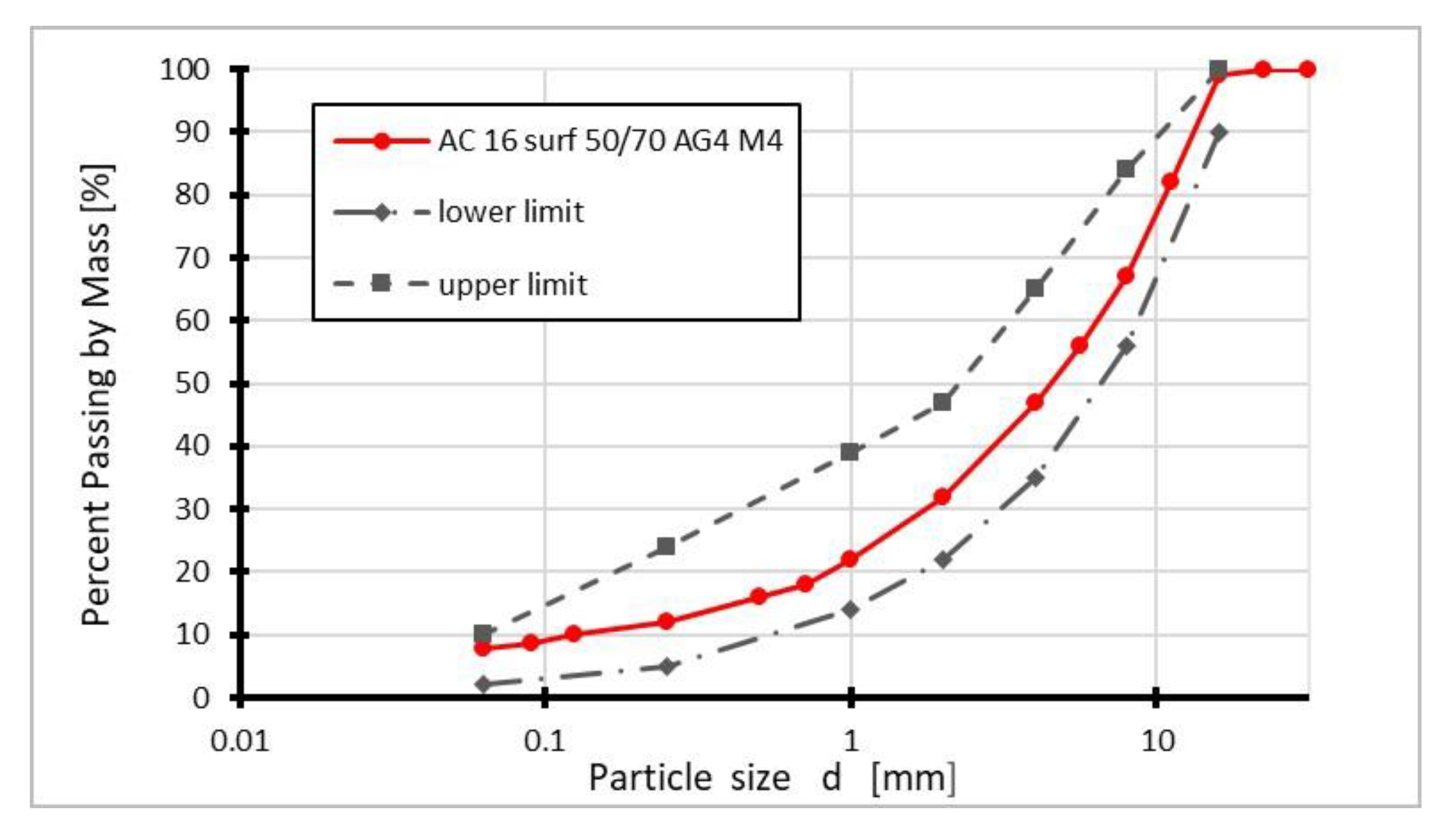

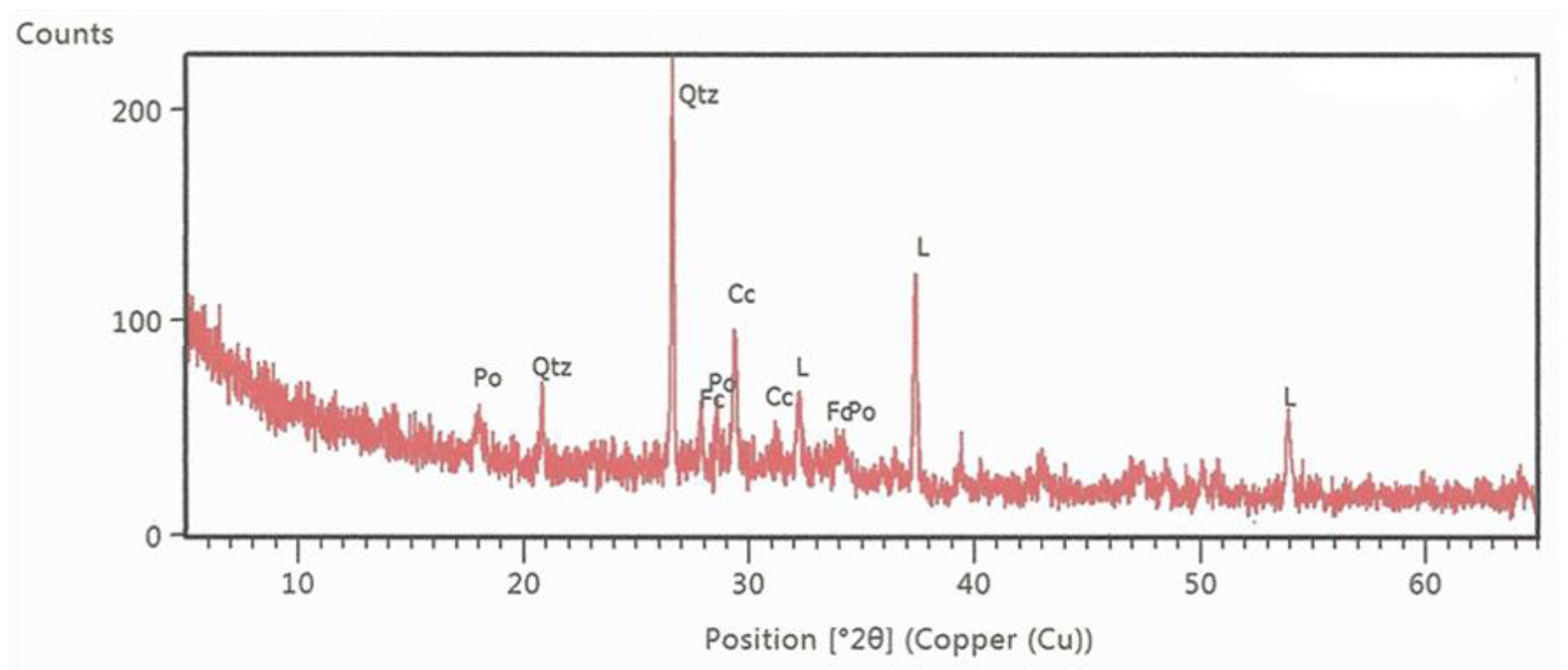
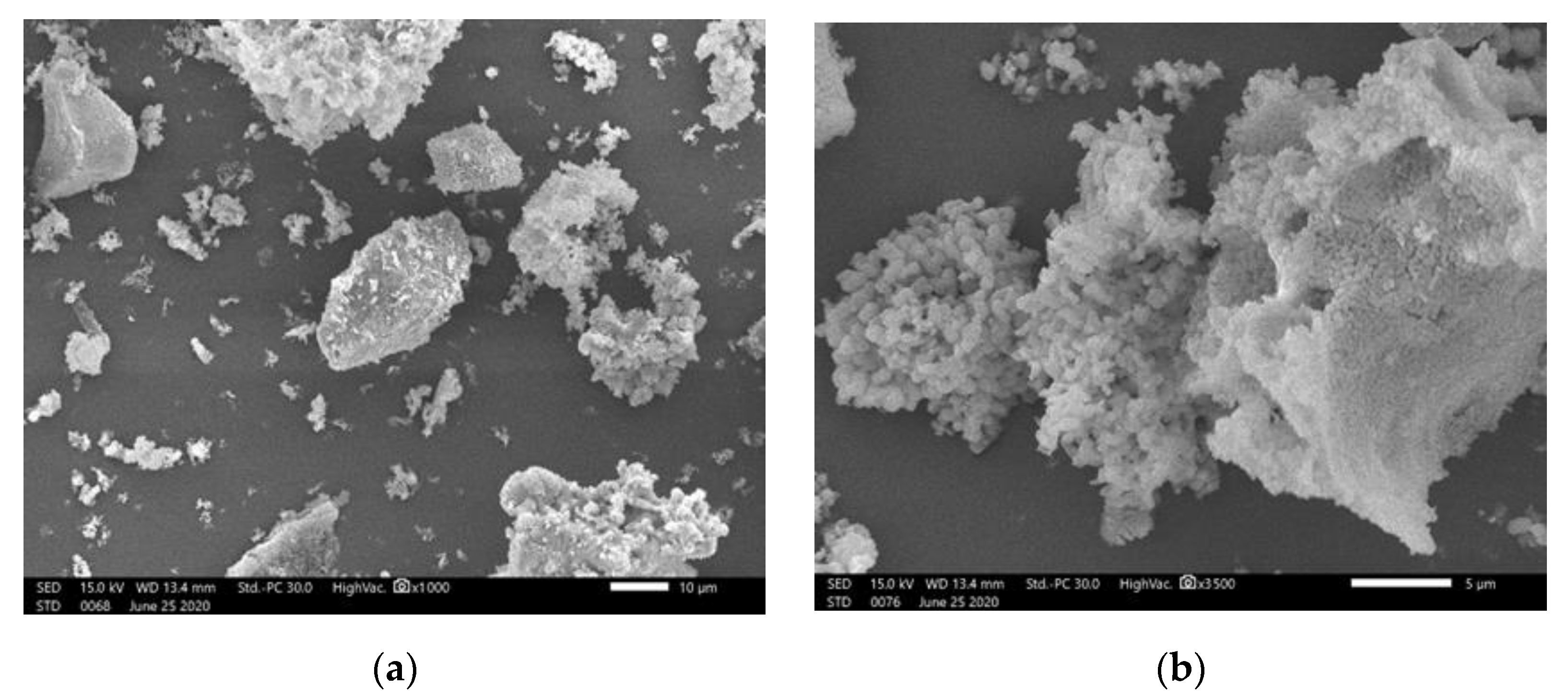

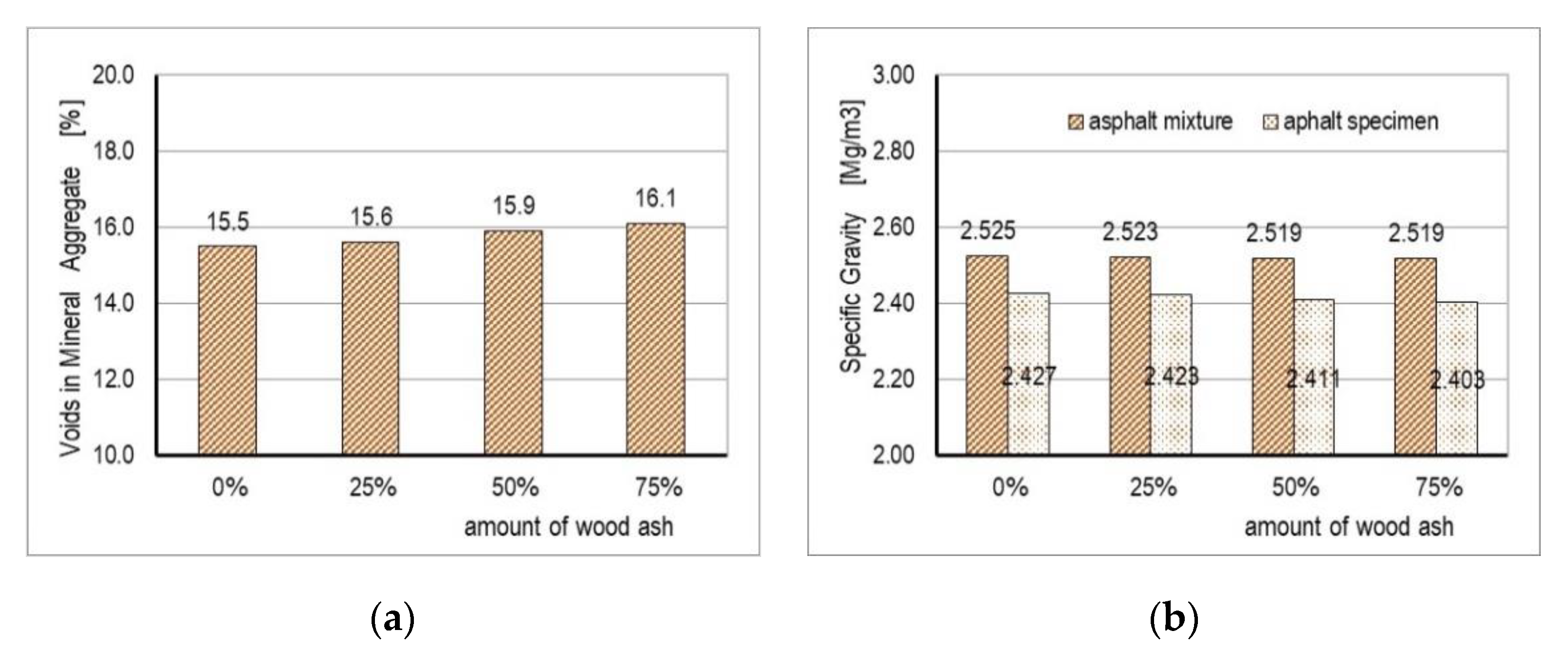
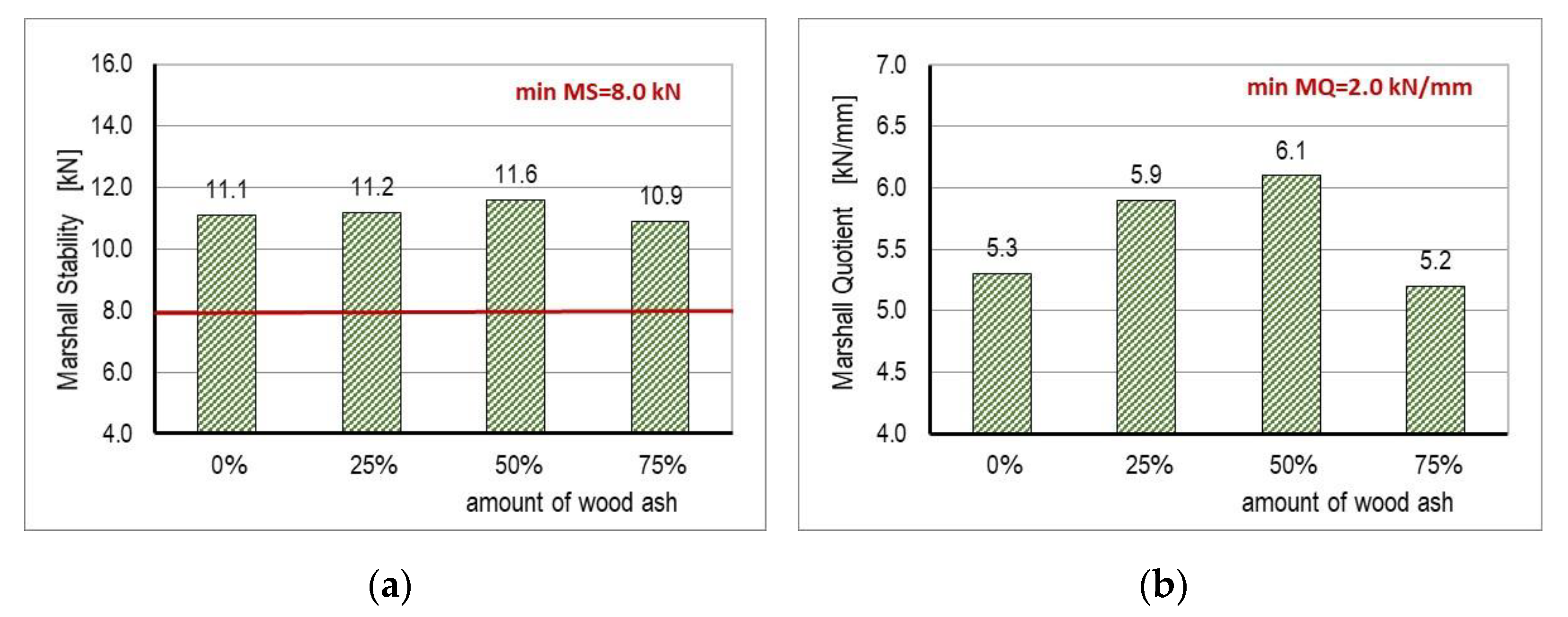
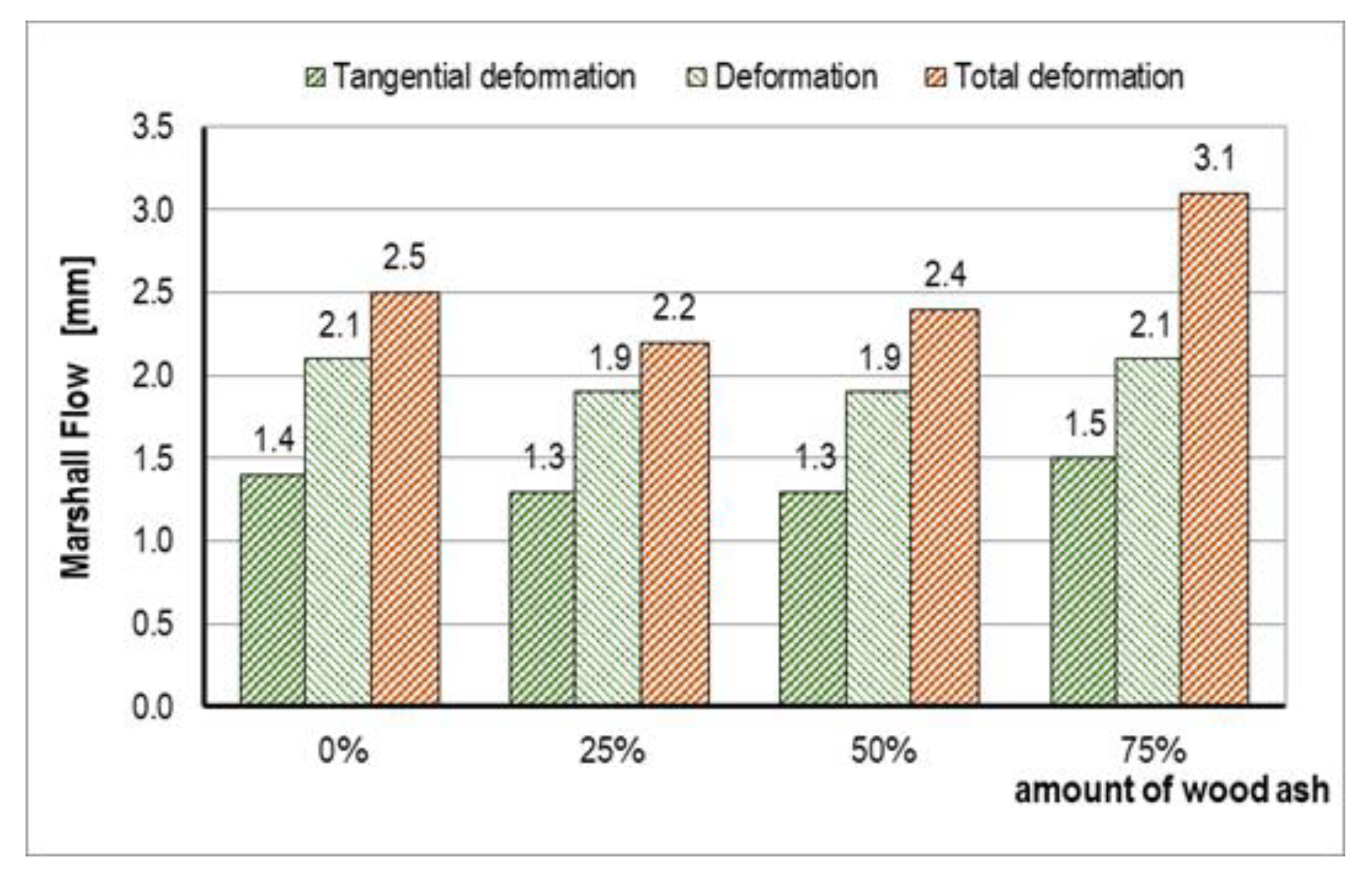

| Properties of Coarse Aggregate | Method | Value |
|---|---|---|
| Crushing resistance by “Los Angeles” method | HRN EN 1097-2 | LA30 |
| Surface abrasion resistance | HRN EN 1097-8 Additive A | AAV20 |
| Wear resistance | HRN EN 1097-1 | MDE20 |
| Resistance to polishability | HRN EN 1097-8 | PSV30 |
| Resistance to freezing and thawing | HRN EN 933-6 | WA242 |
| Properties of Fine Aggregate | Method | Value |
| Content of fine particles | HRN EN 933-1 | F10 |
| Quality of fine particles | HRN EN 933-9 | MBF10 |
| Sieve Opening Size (mm) | Cumulative Passing (%) |
|---|---|
| 2.0 | 100 |
| 0.125 | 78 |
| 0.063 | 49 |
| Characteristic | Unit | Test Result | Maximum Allowed Concentration (MAC) |
|---|---|---|---|
| Sulphates | mg/kg DM | 12.900 | 1.000 |
| Content of total dissolved solids (TDS) | mg/kg DM | 53.670 | 4.000 |
| Total chromium (Cr) | mg/kg DM | 1.95 | 0.5 |
| Designation of Mixture | Content of WA in Filler (%) | Content of Voids (%) | Filling of Voids with Bitumen (%) | Voids in Stone Material (%) | Density of Asphalt Mixture (Mg/m3) | Density of Asphalt Sample (Mg/m3) |
|---|---|---|---|---|---|---|
| A | 0 | 3.9 | 75.0 | 15.5 | 2.525 | 2.427 |
| B | 25 | 4.0 | 74.6 | 15.6 | 2.523 | 2.423 |
| C | 50 | 4.3 | 73.0 | 15.9 | 2.519 | 2.411 |
| D | 75 | 4.6 | 71.5 | 16.1 | 2.519 | 2.403 |
Publisher’s Note: MDPI stays neutral with regard to jurisdictional claims in published maps and institutional affiliations. |
© 2021 by the authors. Licensee MDPI, Basel, Switzerland. This article is an open access article distributed under the terms and conditions of the Creative Commons Attribution (CC BY) license (http://creativecommons.org/licenses/by/4.0/).
Share and Cite
Dimter, S.; Šimun, M.; Zagvozda, M.; Rukavina, T. Laboratory Evaluation of the Properties of Asphalt Mixture with Wood Ash Filler. Materials 2021, 14, 575. https://doi.org/10.3390/ma14030575
Dimter S, Šimun M, Zagvozda M, Rukavina T. Laboratory Evaluation of the Properties of Asphalt Mixture with Wood Ash Filler. Materials. 2021; 14(3):575. https://doi.org/10.3390/ma14030575
Chicago/Turabian StyleDimter, Sanja, Miroslav Šimun, Martina Zagvozda, and Tatjana Rukavina. 2021. "Laboratory Evaluation of the Properties of Asphalt Mixture with Wood Ash Filler" Materials 14, no. 3: 575. https://doi.org/10.3390/ma14030575






